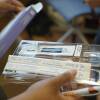Kerry Thompson, who is deafblind, remembers the passage of the American with Disabilities Act well — it was her 10th birthday.
“What was powerful to me, [it] was my first time seeing sign language on my television,” Thompson said. “I had never seen it before.”
This week marked the 32nd anniversary of the signing of the ADA on July 26, 1990, the federal law that prohibits discrimination based on disability. It’s always a special time for Thompson.
“Now every year, I just feel like the ADA is my special birthday present,” she said.
Thompson is now the founder of Boston-based Silent Rhythms, a nonprofit that promotes disability inclusion in the arts. She celebrated the anniversary — and July as Disability Pride Month — with an inclusive dance party at Harvard Wednesday, teaching salsa and American Sign Language classes. A few dozen people spent the sunny afternoon dancing salsa, merengue and bachata together on Harvard’s Science Center Plaza.
More Local News
At the Harvard event, Thompson taught the classes so that people with all types of disabilities could participate. She paused the music often to provide verbal descriptions of each step. She also instructed people how to guide and support a dance partner who may be visually impaired or who may have a mobility or balance issue. There were four sign language interpreters at the event, including a tactile sign language interpreter who was showing Thompson what was going on on the dance floor by making signs onto her back to indicate where people were located and how many people were dancing or laughing.
Through events like Harvard’s, Thompson also wants to call attention to the ADA, which ensures access to the arts, in addition to rights like employment, healthcare and education.
“People don’t realize that the ADA is supposed to cover the right to access cultural affairs. It’s the right to access dance, the arts, theater,” she said. “I think dancing is a really great way to teach awareness and inclusion, and that can help us achieve those other rights even easier.”

Kate Higgins, the associate director of Harvard’s University Disability Resources, which works to create a more accessible campus for students, faculty and staff, joined in the dancing. Thompson took her hands and guided her through a series of salsa steps — side steps, turns and twirls.
“I think too often people with disabilities get excluded from art experiences. And so it felt great as a totally blind person today to be amongst people who showed me how to dance and showed me how to do ASL,” Higgins said. “And even though I didn’t have vision, I wasn’t excluded at all. In fact, it was celebrated that I brought a disability to this event.”
That’s the goal of Thompson’s classes: to bring people together. Silent Rhythms originally taught dance classes for the Deaf community, but over time people with all kinds of disabilities showed interest in learning to dance.
"Dancing itself is a form of communication that you don't need to sign. You don't need to speak verbally. ... You can learn so much and communicate so much without saying a single word."-Kerry Thompson, founder of Silent Rhythms
“I’m really trying to bridge the gap between the Deaf community and the Blind community because I’m part of both of their communities,” Thompson said. “And I want the Deafblind community to feel they have a place in both those communities.”
Nicolas Gort Freitas, a PhD student in biology at Harvard Medical School, has been learning ASL for about a year. He was all smiles as he salsa-ed across the plaza and practiced his ASL. “Very warm,” he said about how he felt. “Both ways — warm emotionally [as well as physically].”
Thompson, who got her master’s degree at the Harvard Graduate School of Education, regularly taught salsa classes before the pandemic. Harvard’s event was one of the few times she’s been able to teach an in-person class over the past two years.

“A very big part of the way I communicate [is] through touch,” Thompson said. “But you can imagine how isolating it was during the pandemic to just be in this bubble and not have an easy way to connect with the world as the world was shifting to virtual spaces.
“So coming together with other people was just powerful,” she added. “And dancing itself is a form of communication that you don’t need to sign. You don’t need to speak verbally. When you come together, you can touch each other and you can learn so much and communicate so much without saying a single word.”









